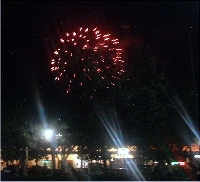
United States National Holiday
July 4, Independence Day

Adopted on June 29, 1938
National Holiday: July 4, Independence Day, celebrated with a mixture of military parades, family gatherings and fireworks. Commemorates the 1776 independence from Great Britain
On June 29, 1938, by joint resolution of Congress (HJ resolution No. 551; pub. res. no. 127), the Fourth of July was legislated as a Federal holiday with pay for its employees:Resolved by the Senate and House of representatives of the United States of America in Congress assembled, that hereafter whenever regular employees of the Federal Government whose compensation is fixed at a rate per day, per hour, or on a piece-work basis are relieved or prevented from working solely because of the occurrence of a holiday such as New Year's Day, Washington's Birthday, Memorial Day, Fourth of July, Labor Day, Thanksgiving Day, Christmas Day, or any other day declared a holiday by Federal statute or Executive order, or any day on which the departments and establishments of the Government are closed by Executive order, they shall receive the same pay for such days as for other days on which an ordinary day's work is performed. Section 2. The joint resolution of January 6, 1885 (USC., title 5, sec. 86), and all other laws inconsistent or ion conflict with the provision of this Act are hereby repealed to the extent of such inconsistency or conflict. Approved, June 29, 1938.
United States National Holiday: July 4, Independence Day
On January 14, 1941, it was brought to the attention of Congress by Robert Ramspeck, Chairman, Committee on the Civil Service of the House of Representatives (see 77th Congress, House of Representatives Report No. 532), that the 1938 Federal holiday law failed to specify that employees of the Government of the District of Columbia also have the Fourth of July designated as a holiday with pay. Harry B. Mitchell, president of the United States Civil Service Commission responded back on April 7 that his office, as well as the Bureau of the Budget, had no objection to amending the 1938 law to include District of Columbia employees. On May 13, 1941, a "Holiday Leave for Per Diem Employees of the District of Columbia" amendment was enacted with the following change made to the 1938 lawThe Second Continental Congress made the Declaration of Independence the "first formal pronouncement by an organized body of people of the
right to government by choice" and severed colonial ties with England. Members of the Congress adopted Thomas Jefferson's declaration on July
4, 1776, and this date became the birthday of the United States of America.
Independence Day was first celebrated on July 8, 1776 when the Declaration of Independence was read to the public. By the 1880's, the Fourth of July
had become the most significant patriotic occasion in the United States. Congress declared the day a federal legal holiday in 1941. The holiday is
presently celebrated with parades, fireworks, picnics, sporting events, and music, including the "Star-Spangled Banner" and several marches
of John Philip Sousa.







